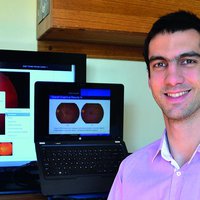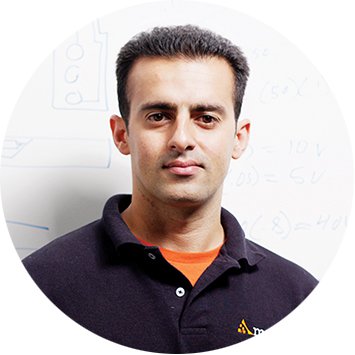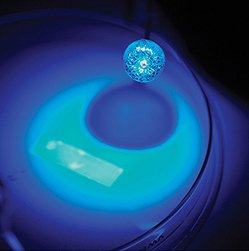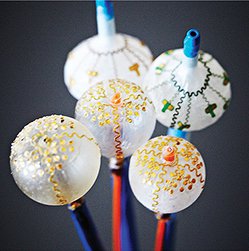When Roozbeh Ghaffari was five years old, his only sibling—a brother named Soran—was born three months prematurely. A few things would eventually emerge about Soran: he was blind and mildly intellectually impaired, he had remarkably acute hearing (and perfect pitch), and he was his older brother’s best friend, superfan, and inspiration. As the elder Ghaffari became an expert in the science and technology of body-machine interfaces and devices that can be integrated into the body (he now leads advanced technology development at MC10, a startup in Cambridge, Massachusetts), Soran remained physically at home in Los Angeles but frequently at his brother’s virtual side, standing by for nightly telephone updates and reading up on his work using text-to-speech software.
Indeed, while Roozbeh Ghaffari’s lifelong interest in the merger of biology and engineering was shaped partly by his parents—his mother is a microbiologist and his father an architect—it was inspired mainly by his brother, whose blindness was caused by retinal damage from excessive oxygen exposure in the neonatal intensive-care ward. “What I found was that my goals were all driven by him,” he says. “I wanted to work on the retinal implant project at MIT, right from year one as an undergraduate.”
He didn’t succeed at finding funding for that daunting challenge. But as a graduate student in the Harvard-MIT Division of Health Sciences and Technology, he shifted to another critical problem, this time inspired by his brother’s sharp hearing rather than his deficient eyesight. Ghaffari’s goal was to unravel the mysteries of the cochlea—that “biological black box with thousands of moving parts in a fluid” that transforms vibrations in the inner ear into nerve signals. “How do we hear with such remarkable sensitivity?” he asks. “How can we process both the roaring sound of jet engines and the sound of pins dropping?”
Focusing on a cochlear structure called the tectorial membrane, he managed to build a system that could measure what the structure was actually doing. “It supports a traveling wave of energy that can propagate along the cochlea. That hadn’t been known before,” he says. And this could help explain how the human ear can detect both very loud and very soft sounds, as well as a wide range of pitches.
After taking a Harvard Business School class focusing on commercializing science, and meeting venture capitalist Carmichael Roberts and postdocs in the lab of Harvard chemist George Whitesides, Ghaffari helped develop a business plan for a company called Diagnostics for All, which is commercializing paper-based diagnostics invented in Whitesides’s lab.
Next, with Roberts and Whitesides serving as the matchmakers, Ghaffari met John Rogers, a materials scientist at the University of Illinois. Rogers was fabricating stretchable electronic devices using polymers and ultrathin semiconductors, such as silicon. But the technology was looking for an important problem to solve. So in 2008 Ghaffari was brought on as cofounder of MC10. The founders considered what kinds of flexible or stretchable products they might enhance with electronics (they even considered contact lenses), but within a couple of months they had settled on balloon catheters and health-monitoring skin patches.
Today, the devices under development add electronics and sensors to balloon catheters. Existing versions of these devices are snaked into coronary arteries and inflated to compress accumulated plaques that can block blood flow. The new versions can, among other things, sense misfiring cardiac tissue that causes irregular heartbeats called arrhythmias. They can even ablate tiny patches of such tissue without harming the healthy tissue nearby. As always, Soran is eager to hear all about it. “He’ll go look up ‘ventricular tachycardia’ and grill me night and day: ‘What is this disorder? What are you guys doing?’” Ghaffari says.
Someday Ghaffari may yet build what his brother needs: a bionic replacement for his damaged retina. In the meantime, he is finding new ways to create other devices that promise to help others. While its catheters still need regulatory approval, MC10 has launched a thin $150 cap that athletes, such as football or hockey players, can wear inside their helmets to indicate the severity of blows to the head. By lighting up red, yellow, or green LEDs on the cap, the technology could indicate whether the wearer might have suffered a worrisome head impact.
When Soran comes to Boston, Ghaffari brings him to the MC10 lab and lets him hold and feel the electronic skullcaps and the instrumented catheters, with their intricate patterns of ultrathin, stretchable sensors. But even when Soran is home in Los Angeles, Ghaffari says, the following question he inspires is in the back of his mind every day: “How can we turn technology into something useful that integrates with the human body?” And every evening, Soran is on the other end of the line, helping him answer that question.
—David Talbot






